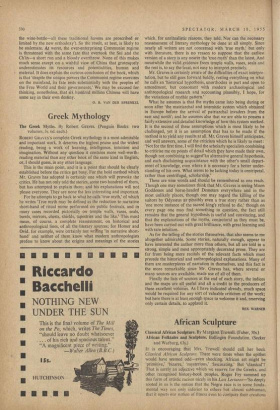Greek Mythology
The Greek Myths. By Robert Graves. (Penguin Books: two volumes, 3s. 6d. each.) ROBERT GRAVES'S complete Greek mythology is a most admirable and important work. It deserves the highest praise and the widest reading, being a work of learning, intelligence, intuition and imagination. Without any question it contains more well-worth- reading material than any other bciok of the same kind in English, or, I should guess, in any other language.
This is the main point, and it is a point that should be clearly established before the critics get busy. For the bold method which Mr. Graves has adopted is certainly one which will provoke the critics. He has not only told the stories, some two hundred of them, but has attempted to xplain them; and his explanations will not please everyone. They are none the less interesting and important.
For he attempts to go back to what he calls 'true myth,' of which he writes 'True myth may be defined as the reduction to narrative short-hand of ritual mime performed on public festivals, and in many cases recorded pictorially on temple walls, vases, seals, bowls, mirrors, chests, shields, tapestries and the like.' This must mean, of course, a complete reassessment, on historical and anthropological lines, of all the literary sources; for Homer and Ovid, for example, were certainly not writing 'in narrative short- hand' and neither of them knew what modern anthropologists profess to know about the origins and meanings of the stories which, for unritualistic reasons, they told. Nor can the necessary reassessment of literary mythology be done at all simply. Since nearly all writers are not concerned with 'true myth,' but only with literature, there is no reason to suppose that the earliest version of a story is any nearer the 'true myth' than the latest. And meanwhile the valid evidence from temple walls, vases, seals and the rest is, to say the least, not easy to interpret precisely.
Mr. Graves is certainly aware of the difficulties of exact interpre- tation, but he still goes forward boldly, resting everything on what he calls an 'historical hypothesis, unorthodox in part and open to amendment, but consonant with modern archeological and anthropological research and accounting plausibly, I hope, for the variations of mythic pattern.'
What he assumes is that the myths came into being during or soon after 'the matriarchal and totemistic system which obtained in Europe before the arrival of patriarchal invaders from the east and north'; and he assumes also that we are able to possess a fairly extensive and detailed knowledge of how this system worked. It is the second of these assumptions which is most likely to be challenged, yet it is an assumption that has to be made if the method is to yield any results at all. Mr. Graves himself anticipates, and well answers, some of the criticism which he is likely to meet : 'Not for the first time, I will find the scholarly specialists combining to criticise me on points of detail which they have made their own, though not combining to suggesran alternative general hypothesis. and each disclaiming acquaintance with the other's small depart- ment of knowledge, even where it is necessary for a better under- standing of his own. What seems to be lacking today is centripetal. rather than centrifugal, scholarship.'
These are wise words and should be remembered as one reads. Though one may sometimes think that Mr. Graves is seeing Moon Goddesses and horse-headed Demeters everywhere and in the most unlikely places, though one may regard the killing of the suitors by Odysseus as possibly even a true story rather than as 'one more instance of the sacred king's refusal to die,' though on every page one may find something to question, the fact still remains that the general hypothesis is useful and convincing, and that the explanations of the myths, conjectural as they must be, have been carried out with great brilliance, with great learning and with rare intuition.
As for the telling of the stories themselves, that also seems to me altogether admirable. Some stories, naturally enough, appear to have interested the author more than others, but all are told in a strong, simple and most appropriately decorated prose. They are far from being mere recitals of the relevant facts which must precede the historical and anthropological explanations. Many of them are masterpieces of narration in themselves, and this fact is the more remarkable since Mr. Graves has, where several or many sources are available, made use of all of them.
Finally the lists of sources at the end of each story, the indices and the maps are all useful and all a credit to the producers of these excellent volumes. As I have indicated already, much space would be required for any sort of valuable criticism of the work; but here there is at least enough space to welcome it and, reserving only certain details, to applaud it.










































 Previous page
Previous page